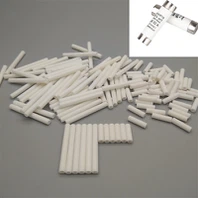Zirconia ceramic, also known as zirconium oxide (ZrO2), is a versatile and high-performance material that has gained widespread use in various industries due to its exceptional properties. Derived from zirconium, zirconia ceramic exhibits remarkable mechanical, thermal, and electrical characteristics, making it an ideal choice for applications ranging from dental implants to cutting-edge electronics.
Mechanical Strength of Zirconia
One of the outstanding features of zirconia ceramic is its exceptional mechanical strength. It boasts high fracture toughness and flexural strength, making it a preferred material for demanding applications. Zirconia's strength is comparable to that of some metals, and its resistance to wear and abrasion is particularly noteworthy. These properties have led to its use in manufacturing components such as cutting tools, bearings, and medical implants.
Biocompatibility
Zirconia ceramic has found widespread use in the field of dentistry, particularly in dental implants and prosthetics. The material's biocompatibility, along with its strength and durability, makes it an excellent choice for dental applications. Zirconia implants are known for their ability to integrate seamlessly with the human body, reducing the risk of rejection and providing a long-lasting solution for individuals in need of tooth replacement.
Thermal Resistance
Zirconia ceramic exhibits excellent thermal resistance, with a melting point exceeding 2,700 degrees Celsius. This high-temperature stability makes it suitable for applications where extreme heat is a factor. Zirconia is commonly used in refractory materials, crucibles, and other components that must withstand elevated temperatures. Its low thermal conductivity also makes it an effective insulator in certain situations.
Electrical Properties
In addition to its mechanical and thermal properties, zirconia ceramic possesses interesting electrical characteristics. It is an excellent ionic conductor at elevated temperatures, making it valuable in applications such as solid oxide fuel cells (SOFCs). The material's conductivity can be enhanced through the introduction of dopants, allowing for customization to meet specific electrical requirements.
Translucency and Aesthetics
Zirconia ceramics have gained popularity in the field of aesthetic dentistry due to their translucency and color options. Dental restorations made from zirconia can closely mimic the natural appearance of teeth, providing both strength and aesthetic appeal. This combination of properties has made zirconia a preferred material for dental crowns and bridges.
Engineering and Industrial Applications
Beyond dentistry, zirconia ceramic has diverse engineering and industrial applications. Its hardness and wear resistance make it suitable for manufacturing cutting tools, grinding media, and ball bearings. The material's chemical inertness also contributes to its use in aggressive environments, such as chemical processing plants. Zirconia's ability to withstand harsh conditions makes it a valuable component in various industrial settings.
Emerging Technologies
Zirconia ceramic continues to play a vital role in the development of emerging technologies. Its use in electronics, particularly in the production of oxygen sensors and solid oxide fuel cells, highlights its importance in advancing energy-efficient and environmentally friendly technologies. The unique combination of properties exhibited by zirconia makes it a material of interest in research and development across multiple disciplines.
Challenges and Considerations
While zirconia ceramic offers numerous advantages, it is not without challenges. The material can be brittle under certain conditions, and its processing requires specialized techniques. Researchers and engineers continually work to address these challenges and further enhance the performance and versatility of zirconia ceramic for a wide range of applications.
In short, zirconia ceramic stands out as a remarkable material with a diverse range of applications, from industrial settings to cutting-edge medical technologies. Its unique combination of mechanical strength, biocompatibility, thermal resistance, and electrical properties positions it as a material of choice for various demanding applications, showcasing its importance in advancing technology and improving the quality of life.




